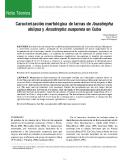| dc.description.abstract | El objetivo de este trabajo fue la diferenciación morfométrica de Anastrepha obliqua (Macquart) y Anastrepha suspensa (Loew), partiendo de los caracteres taxonómicos de mayor importancia en el diagnóstico de larvas del tercer estadio. Se realizaron montajes de los espiráculos anteriores y posteriores, así como del esqueleto cefalofaríngeo, y se midieron las estructuras que los conforman. El gancho bucal y el número de carinas orales no mostraron diferencias significativas sin embargo, la longitud del esqueleto cefalofaríngeo evidenció diferencias entre ambas especies. El número de túbulos de los espiráculos anteriores presentó rangos de 10-17 y 9-15 para A. obliqua y A. suspensa, respectivamente. Además, se determinó que el diámetro de la base de los espiráculos anteriores fue de 117,0-150,8 micrometros y 91,0-137,8 micrometros para ambas especies, respectivamente. A. obliqua presenta un menor número de pelos en los espiráculos posteriores, más largos y ramificados que en A. suspensa. This paper describes morphometric differences between Anastrepha obliqua (Macquart) and Anastrepha suspensa (Loew), taking into consideration the most important taxonomic characters for the diagnosis of third instar larvae. Slide mounts of anterior and posterior spiracles and the cephalopharyngeal skeleton were carried out. The more relevant structures were measured. Neither the mouthhook nor the oral ridges showed significant differences between the two species, while the length of the cephalopharyngeal skeleton did show differences between both species. Values for the number of tubules in anterior spiracles ranged from 10 to 17 and from 9 to 15 for A. obliqua and A. suspensa, respectively. The base diameter of the anterior spiracles ranged from 117.0 to 150.8 micrometers and 91.0 to 137.8 micrometers for A. obliqua and A. suspensa, respectively. A. obliqua has less spiracular hairs, which are longer and more split that in A. suspensa | es_ES |


